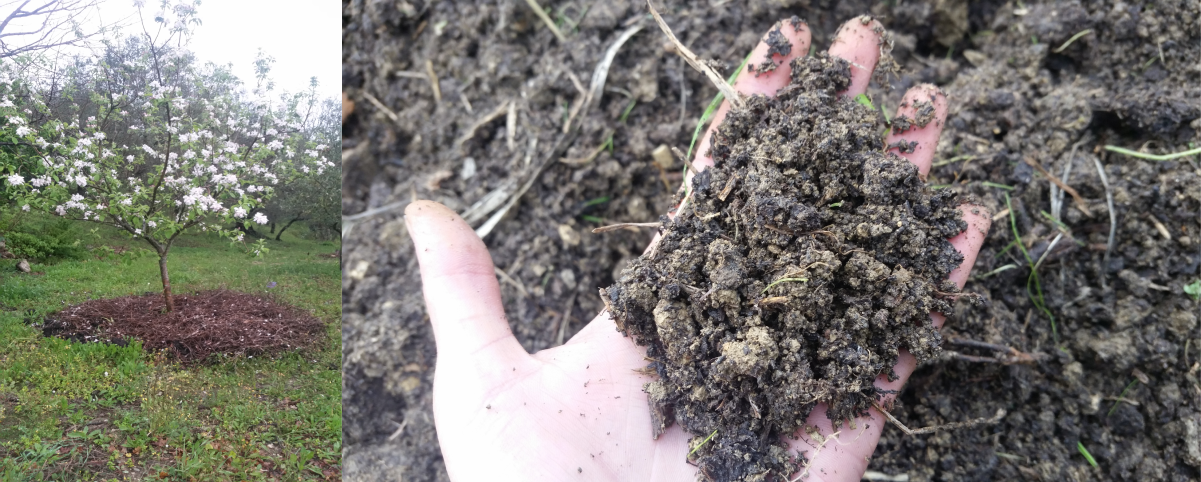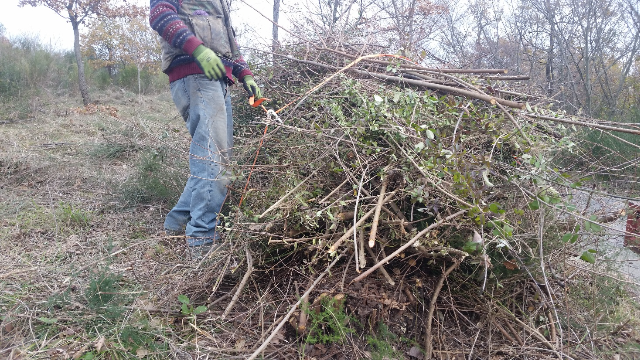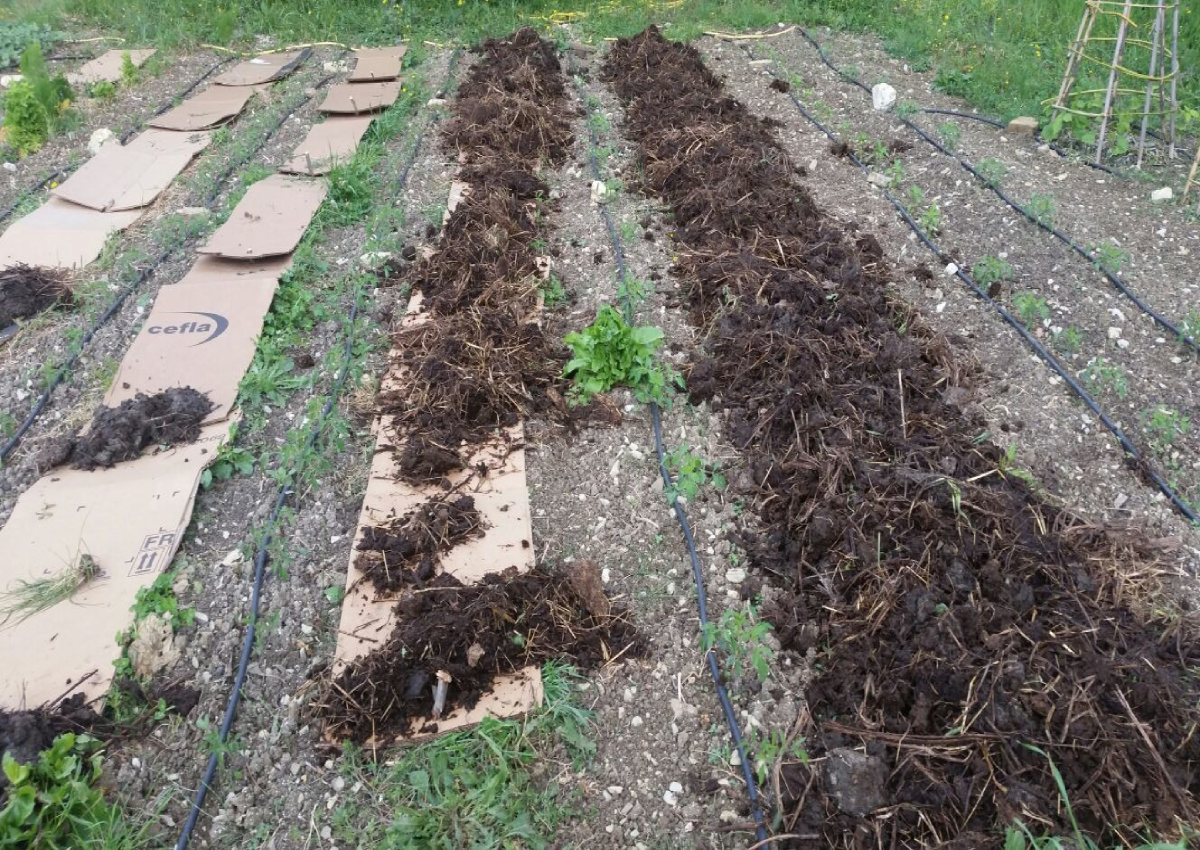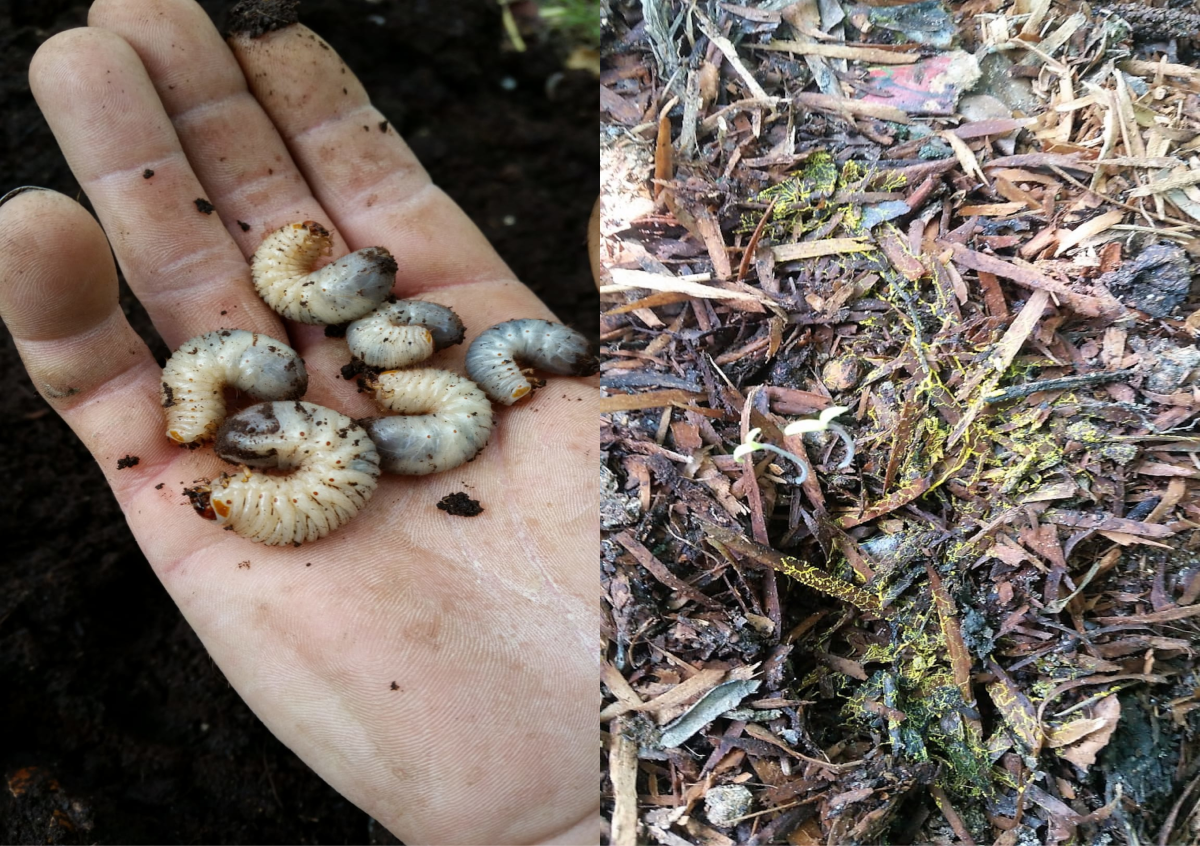It’s 2025, and as I lift the thick layer of woodchip mulch laid out at the bottom of an apple tree, a lively scene is suddenly interrupted.[1] A worm tries to wiggle its way back into the soil; a group of woodlice disperses frantically away from the light; and several beetles and spiders scurry back into the darkness. In one corner of the uncovered ground, I notice a few white fuzzy filaments of mycelium spreading across the woody debris. The soil underneath the woodchips feels damp and cool.A moist, earthy smell arises from it, revealing the millions of bacteria and other microorganismsnot visible to the naked eye that make this their home.
Seven years earlier, I would have not encountered this bustling “underground city” (Tsing 2011: 5). In fact, an act as seemingly gentle as planting a seedling would have caused my fingers to bleed. Back then, the soil of my smallholding was severely compacted and highly unproductive. In the first couple of years it was incredibly difficult to grow any food without the use of mechanical means, plus enormous amounts of water and external inputs like fertilizers and pesticides.
In this photo-essay about mulch and its (de)composition, I reflect upon my practice and experience of growing soil with mulch as a way to explore the relationship between infrastructures and autonomy in agroecological food production. I do so by conceptualizing mulch as a multispecies infrastructure (de)composed by agroecological farmers and billions of soil organisms, and by attending to the material and affective exchanges between humans and nonhumans that mulch enables. Framing mulch as a multispecies infrastructure allows us to challenge notions of autonomy as an exclusively human achievement by revealing the more-than-human relations and collaborative practices that contribute to it.

The particular soil ecology in question lies at the foothills of a mountain in southern Italy, in an area that has been subject to land degradation for some time (Forino et al. 2015). Soil damage here has been fueled by socioeconomic policies implemented over the last century to modernize and industrialize agriculture. In this montane ecology, with its steep slopes, shallow clay soils and rocky terrain, the adoption of productivist agricultural models and technologies such as tractors, tillers, synthetic fertilizers and pesticides, have caused the depletion of soils through processes of erosion, pollution, removal of organic matter and loss of biodiversity. As the photographs below demonstrate, the wounds left by these developments were physically inscribed in the tough and unproductive tilth I encountered when I first started farming this land.

As soil degrades and loses its fertility, farming becomes increasingly reliant upon mechanical and chemical inputs: tractors and tillers are needed to break the hard pan and allow better water infiltration and aeration; water requirements intensify; pesticides become vital for the prevention of fungal and bacterial diseases; and synthetic fertilizers are necessary to feed crops (Gliessman 2007). This, in turn, locks farmers into relationships of dependence with agrochemical companies and their products, along with outside expert knowledge, as well as state and non-state infrastructures for water and other inputs (e.g. fossil fuels). These conditions ultimately reduce farmers’ autonomy in decision-making and in action, inhibiting their ability to take care of the land by farming it the way they see fit, and diminishing their resilience to climate change and infrastructural failures (van der Ploeg 2010; Diković 2025).
It is in the context of this exhausted soil undermining my autonomy as a grower that I began to think about and experiment with mulch.
Mulch is generally known as material used in gardening and agriculture to insulate, protect and enrich soils, but what if we were to think of it as a multispecies infrastructure for actually growing the soil? What would such a conceptualization reveal about the relationship between farmers and their soils, and the kinds of infrastructural interventions needed for their autonomy?
A mulch may be created with a variety of organic and inorganic materials, many of which can be produced on the farm, gathered for free or acquired cheaply. Some of the materials I have used include cow manure from neighbouring farms, discarded leaf-litter and grass clippings from the village, cardboard boxes from local shops, ash from my woodburner, self-produced compost and woodchips, cover crops and more. Each of these mulches has its own material specificities, but they all perform some key basic functions, including shielding the soil from climatic extremes, protecting it from erosion and compaction, absorbing and retaining water, and adding organic carbon and nutrients.
However, a mulch is also more than the sum of its materials. As an agroecological practice, mulching has a long and diverse history, having been widely employed by farmers as a flexible and informal strategy to manage their land and resources sustainably without, and despite, the state and other external actors (Gliessman 2007). By recycling and reusing agricultural by-products – such as animal manure, crop residues and tree prunings – as mulch, farmers sponsor their own soil fertility and enact an ethic of care for the land which is fundamental to their identity and sense of autonomy (Diković 2025). Hojarasca (‘leaf-litter’) (Lyons 2020), lithic mulches (Lightfoot 1996), “slash/mulch” practices (Thurston 1997) and living mulches (Paine and Harrison 1993) are just some of the mulching compositions assembled by farming communities across the world to maintain their soils and their livelihoods.



Besides humans assembling and applying mulch to soils, the composition of this infrastructure brings other players onto the scene. Beneath the mulch layer, bacteria, fungi, protozoans, nematodes, earthworms and many kinds of arthropods all gather and begin an energetic feast. They start shredding and chewing, extracting and consuming, digesting and shitting, digging and burrowing, and eventually they die and decompose. Through these cycles of growth and decay they transform, transport and exchange elements and molecules across a vast network of microscopic life in the soil.
It is by way of this more-than-human co-performance of (de)composition in which mulch materials are collected, broken down and exchanged, that soil is grown. The following photographs show some of the nonhuman beings active in mulch (de)composition, revealing it as a multispecies infrastructure in which humans and nonhumans work together towards a common goal: creating a habitat to support their way of life – the very soil itself (Puig de la Bellacasa 2019).


Unlike the use of synthetic inputs, the act of mulching encourages a more embodied and situated engagement with soils. If farmers are able to become experts in the unique ecology of their soil, they can rely less on agrochemical products and better utilize their knowledge of how to grow food while taking care of the land and its resources. Mulch is thus not so much a tool but a material intermediary, one that allows farmers to work with soil organisms to cultivate autonomy.
After seven years of (de)composing various mulches on my smallholding, the soil ecology has begun to change and so has my autonomy as a grower. The soil has become darker and crumblier, a more diverse vegetation is beginning to grow, and under the sheltering darkness of mulch a vibrant soil community has formed. Assembling mulch has also instigated new relations and collaborations with neighbouring farms, provoking conversations and the sharing of knowledge and practices. Moreover, these new social and ecological relations have allowed me to alter my farming practices and resource use. I now require significantly less water to irrigate my crops, I spend less time weeding, and the work of tilling and fertilizing the land is carried out with a regenerated and diverse soil community.
Undoubtedly, assembling mulch can often entail physically hard work, and the benefits it generates are not as immediate as when using synthetic fertilizers or weedkillers. Many farmers are also constrained in their choices by regulations, markets and other financial mechanisms, and mulch − on its own − cannot address these wider structural issues. Nevertheless, investing time and effort in managing resources and growing soils with mulch can also bring a sense of fulfilment and the dignity that comes with autonomy. It was certainly rewarding for me to observe the soil community at work and how it changed over time, seeing trees and crops getting stronger and less thirsty thanks to mulch, and being able to produce and eat healthy food through this (de)composition work.
The material politics that mulch enables is thus one of rearrangement and recomposition, rather than opposition and contestation (Papadopoulos 2018). It is by readjusting the flows of energies and materials within an agroecosystem and by nourishing human–soil relations that mulch can reconfigure the political and economic space of action for food producers. This “minor” (Barua 2023) account of a multispecies infrastructure might not satisfy some interpretations and readings of infrastructural politics. Transformation here occurs literally underground, and it is necessarily slow, being reliant upon and adjusted to the more-than-human needs and temporalities of soil (Puig de la Bellacasa 2019). Nevertheless, reframing mulch from a passive material substrate to a multispecies infrastructure encompassing “unknown, overlooked and undervalued worlds of non-human species” (Morita 2017: 754) recognizes the more-than-human relations and practices that are key to the survival and autonomy of many human collectives. In the case of agroecological food production, growing soil is a way of growing autonomy, a process that starts and ends with the work of (de)composition, and one that can be facilitated by mulch.
Barua, Maan. 2023. “On Urban Photography: Infrastructure in a Minor Key.” Roadsides 10: 56–61. https://doi.org/10.26034/roadsides-202301008
Diković, Jovana. 2025. The Laissez-Faire Peasant: Post-Socialist Rural Development in Serbia. London: UCL Press.
Forino, Giuseppe, Silvia Ciccarelli, Simone Bonamici, Luigi Perini and Luca Salvati. 2015. “Developmental Policies, Long-Term Land-Use Changes and the Way Towards Soil Degradation: Evidence from Southern Italy.” Scottish Geographical Journal 131 (2): 123–40.
Gliessman, Stephen R. 2007. Agroecology: The Ecology of Sustainable Food Systems. Second Edition. Boca Raton: CRC Press.
Lightfoot, Dale R. 1996. “The Nature, History, and Distribution of Lithic Mulch Agriculture: An Ancient Technique of Dryland Agriculture.” The Agricultural History Review 44 (2): 206–22. https://www.jstor.org/stable/40275100
Lyons, Kristina M. 2020. Vital Decomposition: Soil Practitioners and Life Politics. Durham, NC: Duke University Press.
Morita, Atsuro. 2017. “Multispecies Infrastructure: Infrastructural Inversion and Involutionary Entanglements in the Chao Phraya Delta, Thailand.” Ethnos 82 (4): 738–57.
Paine, Laura K. and Helen Harrison. 1993. “The Historical Roots of Living Mulch and Related Practices”. HortTechnology 3 (2): 137–43. https://doi.org/10.21273/HORTTECH.3.2.137
Papadopoulos, Dimitris. 2018. Experimental Practice: Technoscience, Alterontologies, and More-Than-Social Movements. Durham, NC: Duke University Press.
Puig de la Bellacasa, Maria. 2019. “Re-animating soils: Transforming human–soil affections through science, culture and community.” The Sociological Review 67 (2): 391–407.
Thurston, H. David. 1997. Slash/Mulch Systems: Sustainable Methods for Tropical Agriculture. Boulder: Westview Press.
Tsing, Anna. 2011. “Arts of Inclusion, or, How to Love a Mushroom.” Australian Humanities Review (50): 5–21. https://doi.org/10.22459/AHR.50.2011.01
van der Ploeg, Jan Douwe. 2010. “The peasantries of the twenty-first century: the commoditisation debate revisited.” The Journal of Peasant Studies 37(1): 1–30. https://doi.org/10.1080/03066150903498721